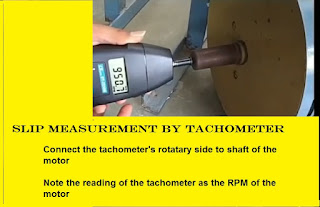What is a slip?
Slip % or slip is the name given for the ratio of rotor speed and synchronous speed (stator rotating magnetic field). It is expressed in percentage (%).
Slip % = n slip / n sync * 100
n slip = Slip speed (Nslip)
nsynch = stator speed (synchronous speed) (Ns)
So measuring slip is nothing but measuring the relative motion of the motor.
*Rotor speed (Nr) - rotatory speed of the motor
What is a slip speed (n slip)?
Slip speed is nothing but differentiation between synchronous speed (stator speed) and rotor speed nr.
n slip = Slip speed (Nslip)
n syn = stator speed (Ns) (synchronous speed)
nr= rotor speed (Nr)
Slip measurement method
There are three common methods used by engineers and electricians for measuring the slip of the motors.
- Tachometer method.
- Galvanometer method.
- Stroboscopic method.
In this blog, you will get more information about the slip and sample problem with a solution. The specialty of this article that you will get information in a practical way.
Measurement of slip using tachometer method
Aim.
To measure the slip of a 3-phase induction motor by the Tachometer method.
Apparatus required
A tachometer is a device used to measure the rotor speed of the motor.
paper, pen, and pencil. These apparatus are enough to finish the experiment.
Formula to calculate slip of induction motor
N slip =Ns - Nr ----------- 1
Slip % = (N slip / Ns) * 100------------- 2
N slip - Slip speed
Ns- Synchronous speed
Nr- Rotor speed
Ns=120f/P
f - Frequency
P - Number of Poles in the motor
Concept of tachometer method
The device tachometer helps us to find the Rotor speed (Nr) which is the rotatory speed of the motor.
The formula Ns=120 f / P helps us to identify synchronous speed (Ns).
Familiarizing with the device tachometer
- First, familiarize yourself with the buttons and settings of the device by reading nameplate of the device.
- There are two types of tachometer i) contact- type or ii) Non- contact type. Check what type of tachometer do you have?
- Contact type tachometers will have rotating shaft or spinner.
- Non- contact type tachometer will have beam light as a sensor.
How to use a tachometer to measure motor speed RPM?
you can follow these steps for measuring the speed and slip of the induction motor using a device tachometer.
Contact type tachometer for tachometer method
- In Contact type tachometer, couple the shaft of the tachometer to the shaft of the induction motor and wait for the LCD display to show constant RPM value.
- Note down the value as RPM of the motor (Rotor Speed-Nr)
Non-Contact type tachometer for tachometer method
- In non-Contact type tachometer, focus the beam of light to the shaft of the induction motor and wait for the LCD display to show constant RPM value.
- Note down the value as RPM of the motor (Rotor Speed-Nr)
Example problem to measure slip of induction motor using a tachometer.
Problem 1.
Measure the slip of the induction motor for the 3 phase induction motor, supplied with 440 voltage, and the number of poles is 6.
Given Data
Voltage - 440 V
Poles- 6
Solution
Connect the spinner of the tachometer to the shaft of the motor, and check for the value in the tachometer display. The value shown by the tachometer is the rotor speed of the motor.
Note down the measured RPM
Nr=936rpm
Nr - Rotor speed (Speed of the motor)
Case-1
Motor speed will vary when load changes. For high loads, the speed of the rotor will decrease.
Now, find the synchronous speed (Ns) or stator speed of the Induction motor
To find the synchronous speed of the induction motor, use the below formula
Ns=120 f / P
Now substitute a number of the poles in the formula
Ns=1000
- The synchronous speed (Ns) is 1000.
- The rotor speed (Nr) is 936
Case (i)
In some cases, you can use the below formula to find the number of poles
P=120 x f / Nr
P= 6
P= Number of poles 6
Final answer
After finding rotor speed (Nr) and Synchronous speed (Ns), you substitute these values in the formula for the answer.
Slip speed
n slip =n sync - n rotor ---------------- 1
Formula-1 Can be written as
Slip speed (Nslip)= Ns- Nr
Nslip=1000 - 936
Nslip=64 rpm
Finally, Slip speed (n slip) or (Nslip) is 64 rpm
Slip Percentage %
Formula-2 Can be written as
Slip % = (N slip / Ns) * 100------------- 2
Slip % = (64/1000) * 100
Slip % = 6.4 % or
Slip or slip of the induction motor is 6.4 %.
Conclusion
Slip measurement helps us to understand the amount of magnetic generation inside the induction motor. If the slip value is higher, it will generate a strong magnetic field around the rotor and creates more torque.
Slip is normally mentioned in percentage. For a large motor, slip may vary from 5 % to 6%, and for a small motor 8% to 9%.

